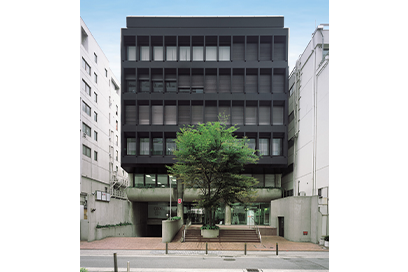
Chapter 3 Development
1958
1988
Section 2. Expanding the Business Through M&A
2. Changing the Building's Name to the Dokita Daibiru Building
-

View of the entire Dokita Daibiru Building
On November 2, 1988, the day after the acquisition procedure for Volkart Japan was completed, the company changed its name to Dojima Estate. The Volkart Building’s name was changed to the Dokita Daibiru Building on January 1, 1989.
The Dokita Daibiru Building had a site area of 849 m2, a building area of 594 m2, and a total floor area of 4,283 m2. It used reinforced concrete construction and had seven aboveground floors, one underground floor, two penthouse floors, and a parking garage that could accommodate 19 cars. The building was designed to have a spacious 11-meter-deep open area facing the front road, enhancing its grade as a building.
It was acquired with tenants already in place, and our company leased the entire property from Dojima Estate. (On November 14, 2006, we acquired the site from Dojima Estate.) We decided to handle the building’s management ourselves, and as we had originally planned, we implemented unified, comprehensive, efficient management of the building together with the adjacent Shin-Daibiru Building.
-
1923 1944 Beginnings
-
Section 2. Launching a Building Management Business
-
Section 4. Business Development in Wartime
-
1945 1957 Reconstruction
-
Section 2. Our Buildings Reopen
-
1958 1988 Development
-
Section 1. Expanding the Building Management Business
- 1. The End of the Requisition of the Hibiya Daibiru Buildings
- 2. Upgrading the Facilities of the Daibiru Buildings and Damage Caused by the 2nd Muroto Typhoon
- 3. The Completion of the North Wing of the Shin-Daibiru Building
- 4. The Completion of the Yaesu Daibiru Building
- 5. The Acquisition of the Midosuji Daibiru Building
- 6. The Completion of the Kojimachi Daibiru Building
- 7. The Completion of the Uchisaiwaicho Daibiru Building
- 8. The Completion of the Dojima Daibiru Building
- 9. The Completion of the Awajimachi Daibiru Building
- 10. The Completion of the Mita-Nitto Daibiru Building
-
Section 2. Expanding the Business Through M&A
-
-
1989 2003 Expansion (1989–2003)
-
Section 1. Creating New Urban Spaces
- 1. The Bubble Economy and Daibiru
- 2. The Hibiya Daibiru Rebuilding Project
- 3. The Completion of the Rebuild
- 4. The Start and Execution of Renovation Plans
- 5. The Completion of the Kita-Umeda Daibiru Building
- 6. The Completion of the Yodoyabashi Daibiru Building
- 7. The Completion of the Estate Tosabori Building
- 8. The Completion of the Umeda Daibiru Building
- 9. The Completion of Violette Takarazuka
- 10. The Shinjuku Daibiru Building and Shiba Daibiru Building Acquisitions
-
Section 2. The Development of a New Corporate Identity and a Name Change
-
Section 3. Disaster Preparedness and Risk Management
-
-
2004 2023 Transformation (2004–2023)
-
Section 1. Becoming a Consolidated Subsidiary of Mitsui O.S.K. Lines and Promoting Management Plans
- 1. Becoming a Consolidated Subsidiary of Mitsui O.S.K. Lines
- 2. Concentrating Investment in the Tokyo Area
- 3. Expanding into Other Countries and Japanese Regions
- 4. Establishing Daibiru 3D-Project Phase I, a Medium-Term Management Plan
- 5. Establishing Our Management Philosophy and Mission Statement
- 6. Establishing Daibiru-3D Project Phase II, a New Medium-Term Management Plan
- 7. Ongoing Establishment of New Medium-Term Management Plans
-
Section 2. Expanding Our Business
- 1. The Akihabara Station Redevelopment Project and the Completion of the Akihabara Daibiru Building
- 2. The Acquisition of the Toranomon Daibiru Building
- 3. The 3 Nakanoshima Joint Development Project and the Completion of the Nakanoshima Daibiru Building
- 4. The Completion of the Tosabori Daibiru Building
- 5. The Acquisition of Aoyama Rise Square
- 6. The 3 Nakanoshima Joint Development Project and the Completion of the Daibiru-Honkan Building
- 7. Rebuilding the Shin-Daibiru Building
- 8. Renovation Work
- 9. Multiple Awards
- 10. Delving into Commercial Facilities
- 11. Acquiring a Partial Interest in the Seavans South Building
- 12. Expansion to Sapporo
- 13. Selling Seven Residential Properties
- 14. Starting the Rebuild of the Midosuji Daibiru Building
- 15. Starting the Rebuild of the Yaesu Daibiru Building
-
Section 3. Overseas Business Expansion
-
Section 4. Further Strengthening of the Corporate Structure and Group Reorganization
-
Section 5. Harmonious Coexistence with Society
- 1. Developing a Compliance System
- 2. Developing an Internal Control System
- 3. Risk Management Measures
- 4. Sustainability Initiatives
- 5. Social Contribution and Cultural Support Initiatives
- 6. Environmental Initiatives
- 7. Working Style Reform Initiatives
- 8. Launching the Brand Development Project
- 9. Launching the Head Office Renovation Project
-
Section 6. Toward Our 100th Anniversary and Beyond
- 1. Becoming a Full Subsidiary of Mitsui O.S.K. Lines
- 2. Acquiring a Partial Interest in Otemachi First Square
- 3. Acquiring a Partial Interest in the Otemon Tower / ENEOS Building
- 4. Investment in an SPC for Logistics Facilities in the Nishinomiya Area
- 5. Project Participation in the United States
- 6. Project Development in Melbourne, Australia
- 7. Formulation of a New Medium- and Long-Term Management Plan
- 8. Implementing 100th Anniversary Projects
- 9. For Future Generations
-



